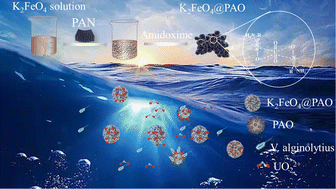Regulating the preparation of antibacterial poly(amidoxime) for efficient uranium extraction from seawater†
Abstract
Seawater is a huge store of uranium, and the related uranium retraction technology has become a critical step in the sustainable development of nuclear power. For obtaining uranium U(VI) from seawater cheaply and environmentally, we introduced K2FeO4 during the polyamidoxime (PAO) preparation process in water to endow PAO with high antibacterial and low agglomeration properties. In this reaction, only water was used as the solvent with the goal of extracting U(VI) from seawater in a low-cost, pollution-free manner. Studies showed that the adsorption of U(VI) on K2FeO4@PAO conformed to a pseudo-second-order model, and the maximum adsorption capacity calculated by the Langmuir model was 137 mg g−1 at 298 K and pH 8.2. Moreover, K2FeO4@PAO showed high selectivity for U(VI) compared with a range of metal ions. K2FeO4@PAO also showed good recyclability, and the recovery rate only decreased by 3% after six cycles. In addition, antibacterial experiments indicated that K2FeO4@PAO could effectively inhibit the growth of Escherichia coli (E. coli) and Vibrio alginolyticus (V. alginolyticus) that are commonly found in seawater.

- This article is part of the themed collection: Sustainable Development Goal 7: Affordable and Clean Energy


 Please wait while we load your content...
Please wait while we load your content...